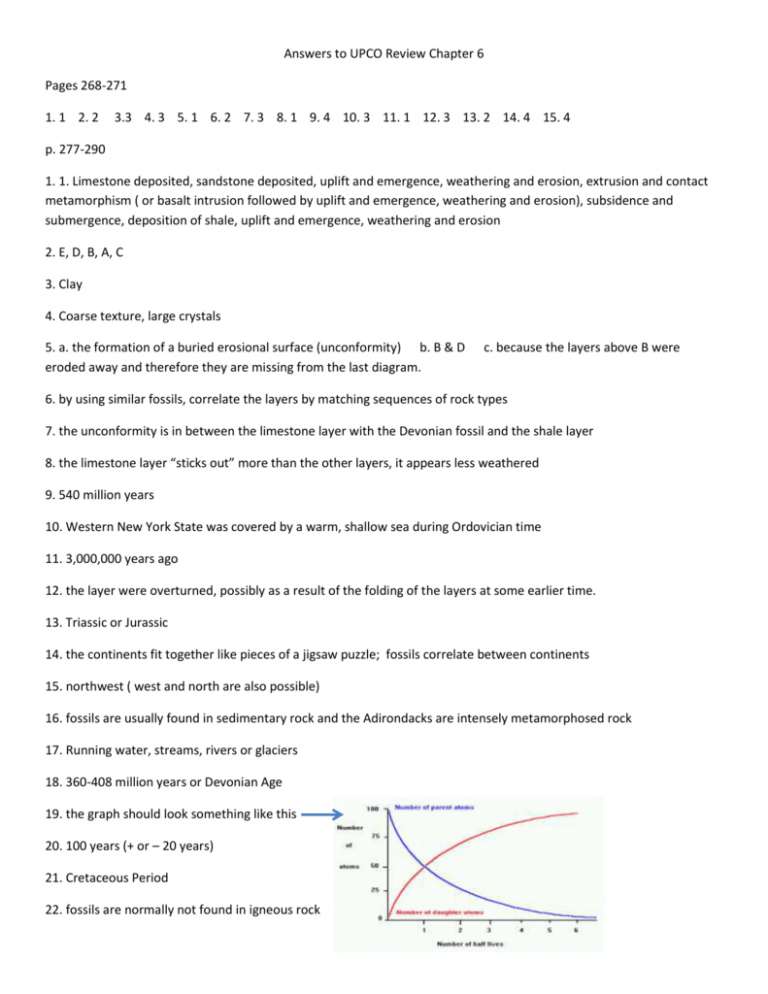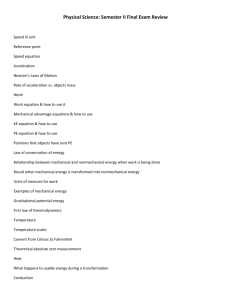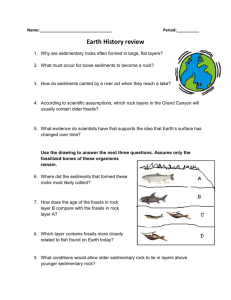Answers to UPCO Review Chapter 6 Pages 268
advertisement

Answers to UPCO Review Chapter 6 Pages 268-271 1. 1 2. 2 3.3 4. 3 5. 1 6. 2 7. 3 8. 1 9. 4 10. 3 11. 1 12. 3 13. 2 14. 4 15. 4 p. 277-290 1. 1. Limestone deposited, sandstone deposited, uplift and emergence, weathering and erosion, extrusion and contact metamorphism ( or basalt intrusion followed by uplift and emergence, weathering and erosion), subsidence and submergence, deposition of shale, uplift and emergence, weathering and erosion 2. E, D, B, A, C 3. Clay 4. Coarse texture, large crystals 5. a. the formation of a buried erosional surface (unconformity) b. B & D eroded away and therefore they are missing from the last diagram. c. because the layers above B were 6. by using similar fossils, correlate the layers by matching sequences of rock types 7. the unconformity is in between the limestone layer with the Devonian fossil and the shale layer 8. the limestone layer “sticks out” more than the other layers, it appears less weathered 9. 540 million years 10. Western New York State was covered by a warm, shallow sea during Ordovician time 11. 3,000,000 years ago 12. the layer were overturned, possibly as a result of the folding of the layers at some earlier time. 13. Triassic or Jurassic 14. the continents fit together like pieces of a jigsaw puzzle; fossils correlate between continents 15. northwest ( west and north are also possible) 16. fossils are usually found in sedimentary rock and the Adirondacks are intensely metamorphosed rock 17. Running water, streams, rivers or glaciers 18. 360-408 million years or Devonian Age 19. the graph should look something like this 20. 100 years (+ or – 20 years) 21. Cretaceous Period 22. fossils are normally not found in igneous rock 23. evidence that the fault is the most recent geological event to have occurred in this area is the fact that all the layers, including the intrusion, have been faulted. They could not have been faulted if they did not exist prior to the fault. 24. the evidence that indicates that rock layer B is younger than rock layers A and C is contact metamorphism which occurs on both the layers above and below it. This indicates an intrusion which can occur only if the other rock layers are already in place. 25. It can be determined that an unconformity occurred at the bottom of rock layer B because the surface is irregular and the layers beneath it are folded. 26. Rock layers C and G were formed before the folding occurred because they could not be folded if they did not exist. 27. Layer 4 is a good time marker because it is a thin layer of volcanic ash. When volcanoes erupt, they spread a thin layer of ask over the entire Earth. When that ash is identified, it is indicative of the age of the rock. 28. The irregular surface between layers 1 and 2 is a buried erosional surface. It occurred when layer 1 was uplifted , eroded , later subsided and was again covered by water in which layer 2 was deposited. 29. the rocks from oldest to youngest are: limestone, shale, sandstone, volcanic ask, shale, limestone and basalt 30. the most recent geologic period that rock layer 6 could possibly be is Devonian, when the armored fish became extinct. 31. the graph looks something like this: 32. If an original sample of radioactive U-238 had a mass of 1600 grams, the amount of the U-238 sample left after 18 billion years would be 6% of 1600 grams or 96 grams. After 18 billion years, 94% of the U-238 would have decayed, leaving 6% remaining. 33. According to the chart, the rock sample is 9 billion years old. 34. Of all the animals listed, the one that is more abundant today than at any time in the past is the insects. 35. Of those listed, the groups that have become extinct are the Ammonites, Trilobites and Dinosaurs. 36. Of those listed, the groups which were more abundant during the Carboniferous than during the Jurassic period are Brachiopods, Frogs and Toads. 37. The dinosaurs became extinct at the end of the Cretaceous period. 38. Of all the animals listed, the horse originated most recently. 39. Of those animals listed, the organisms which originated and became extinct between the Cambrian and Tertiary periods are the Ammonites and Dinosaurs. 40. The environmental change which might have occurred between the end of the Devonian and the beginning of the Triassic period was the uplift of the continents caused by the collision of North America and Africa (the Appalachian Orogeny). The animals that lived in that region were displaced and the plants changed over time.








